Western Sydney University: UTI Case Study Analysis Report
VerifiedAdded on 2023/01/16
|8
|1964
|93
Report
AI Summary
This report analyzes a case study of a 75-year-old male, Mr. Kirkman, who presented to the Emergency Department with symptoms indicative of a urinary tract infection (UTI). The report delves into the pathogenesis of Mr. Kirkman's condition, considering his lifestyle factors such as smoking and social drinking, along with his previous medical history and current clinical manifestations. It examines the interplay of factors contributing to his condition, including heart rate, respiratory rate, and blood pressure. The report then identifies and explains a suitable nursing strategy, artificial ventilation, to address the patient's critical condition, providing a rationale based on relevant evidence. Furthermore, it critically analyzes the patient's arterial blood gas (ABG) results, relating them to the underlying pathogenesis and the patient's overall physiological state. The analysis includes a discussion of pH levels, base excess, and lactate levels, and their implications for Mr. Kirkman's health. The report concludes with a discussion of the patient's condition and the applied nursing strategies.
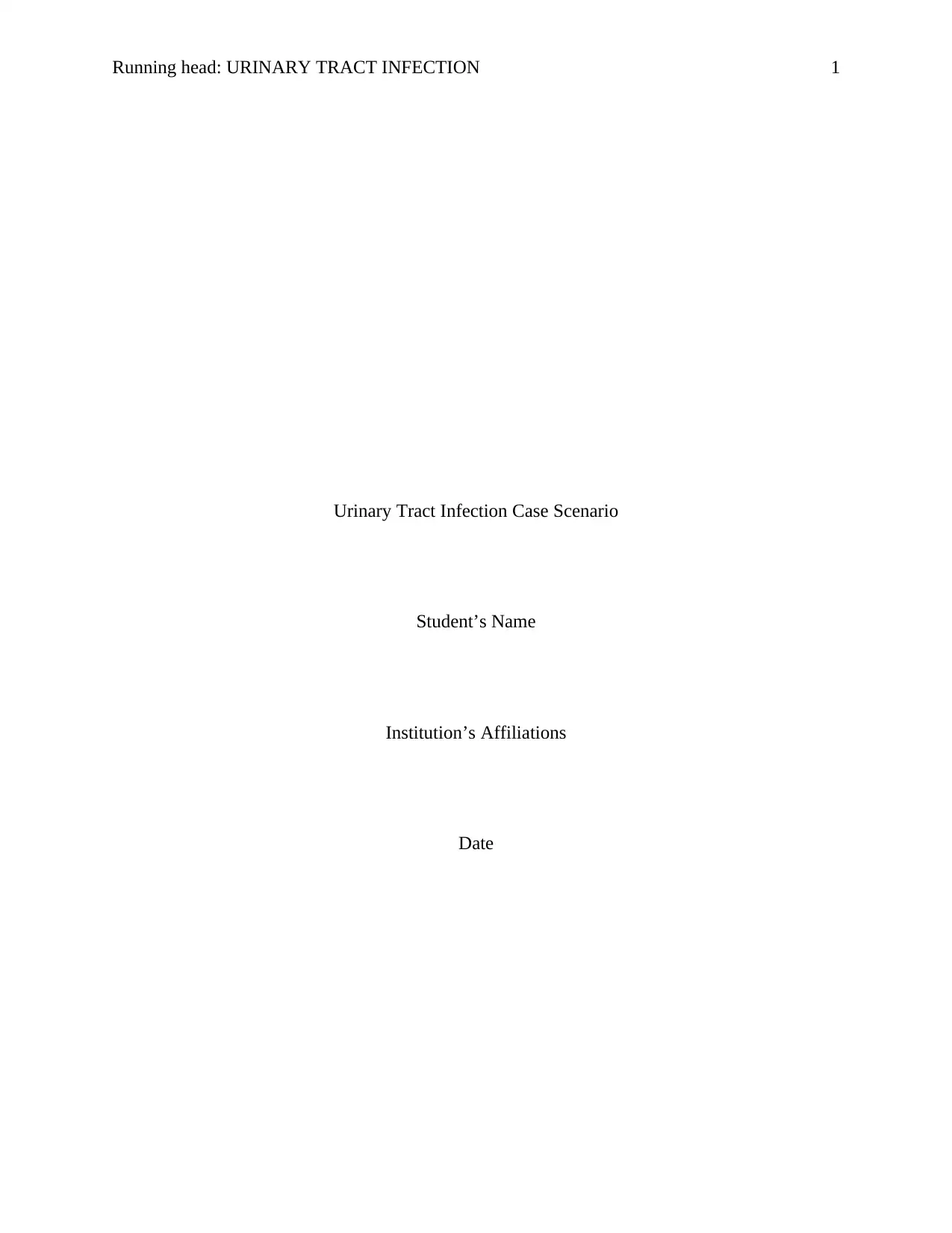
Running head: URINARY TRACT INFECTION 1
Urinary Tract Infection Case Scenario
Student’s Name
Institution’s Affiliations
Date
Urinary Tract Infection Case Scenario
Student’s Name
Institution’s Affiliations
Date
Paraphrase This Document
Need a fresh take? Get an instant paraphrase of this document with our AI Paraphraser
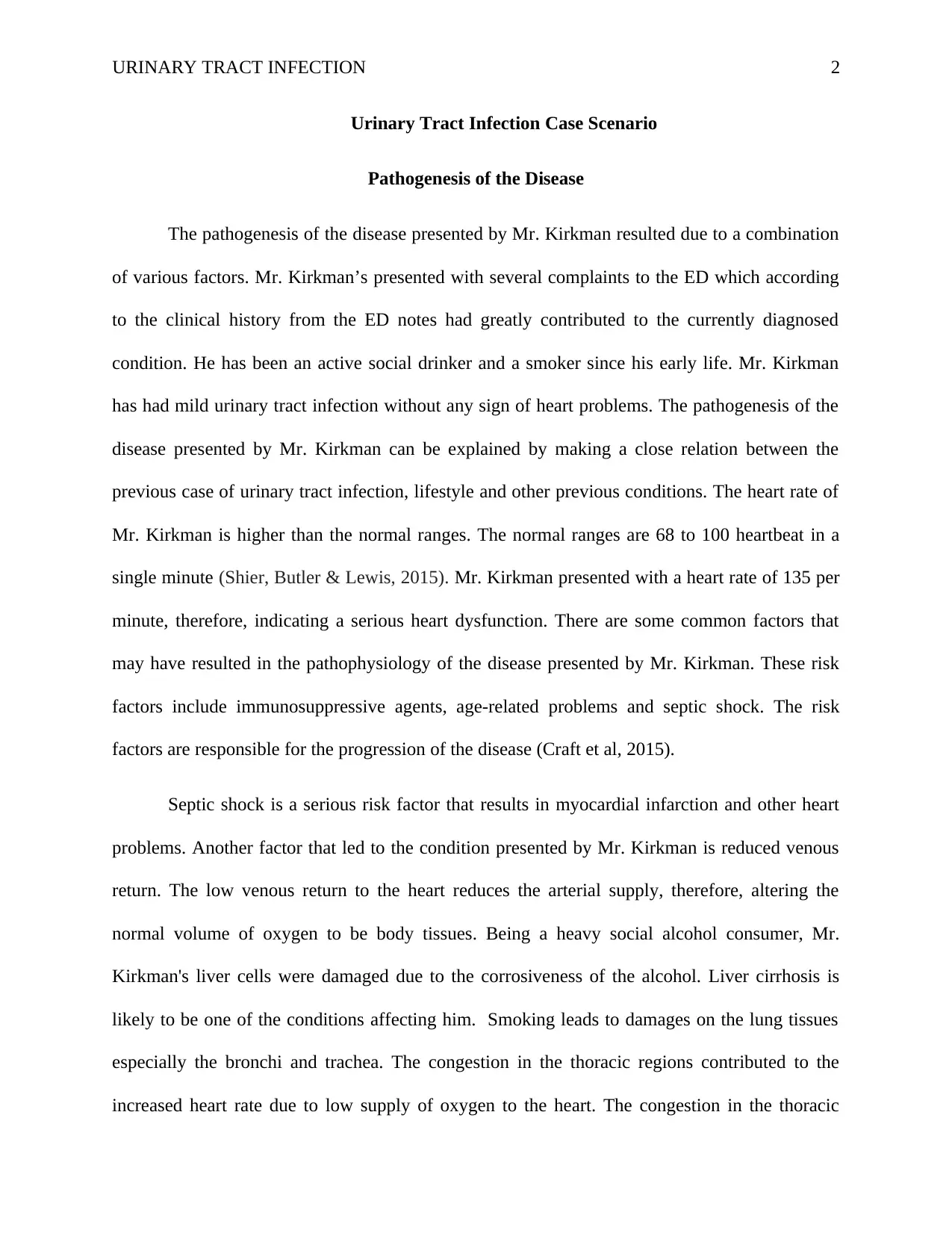
URINARY TRACT INFECTION 2
Urinary Tract Infection Case Scenario
Pathogenesis of the Disease
The pathogenesis of the disease presented by Mr. Kirkman resulted due to a combination
of various factors. Mr. Kirkman’s presented with several complaints to the ED which according
to the clinical history from the ED notes had greatly contributed to the currently diagnosed
condition. He has been an active social drinker and a smoker since his early life. Mr. Kirkman
has had mild urinary tract infection without any sign of heart problems. The pathogenesis of the
disease presented by Mr. Kirkman can be explained by making a close relation between the
previous case of urinary tract infection, lifestyle and other previous conditions. The heart rate of
Mr. Kirkman is higher than the normal ranges. The normal ranges are 68 to 100 heartbeat in a
single minute (Shier, Butler & Lewis, 2015). Mr. Kirkman presented with a heart rate of 135 per
minute, therefore, indicating a serious heart dysfunction. There are some common factors that
may have resulted in the pathophysiology of the disease presented by Mr. Kirkman. These risk
factors include immunosuppressive agents, age-related problems and septic shock. The risk
factors are responsible for the progression of the disease (Craft et al, 2015).
Septic shock is a serious risk factor that results in myocardial infarction and other heart
problems. Another factor that led to the condition presented by Mr. Kirkman is reduced venous
return. The low venous return to the heart reduces the arterial supply, therefore, altering the
normal volume of oxygen to be body tissues. Being a heavy social alcohol consumer, Mr.
Kirkman's liver cells were damaged due to the corrosiveness of the alcohol. Liver cirrhosis is
likely to be one of the conditions affecting him. Smoking leads to damages on the lung tissues
especially the bronchi and trachea. The congestion in the thoracic regions contributed to the
increased heart rate due to low supply of oxygen to the heart. The congestion in the thoracic
Urinary Tract Infection Case Scenario
Pathogenesis of the Disease
The pathogenesis of the disease presented by Mr. Kirkman resulted due to a combination
of various factors. Mr. Kirkman’s presented with several complaints to the ED which according
to the clinical history from the ED notes had greatly contributed to the currently diagnosed
condition. He has been an active social drinker and a smoker since his early life. Mr. Kirkman
has had mild urinary tract infection without any sign of heart problems. The pathogenesis of the
disease presented by Mr. Kirkman can be explained by making a close relation between the
previous case of urinary tract infection, lifestyle and other previous conditions. The heart rate of
Mr. Kirkman is higher than the normal ranges. The normal ranges are 68 to 100 heartbeat in a
single minute (Shier, Butler & Lewis, 2015). Mr. Kirkman presented with a heart rate of 135 per
minute, therefore, indicating a serious heart dysfunction. There are some common factors that
may have resulted in the pathophysiology of the disease presented by Mr. Kirkman. These risk
factors include immunosuppressive agents, age-related problems and septic shock. The risk
factors are responsible for the progression of the disease (Craft et al, 2015).
Septic shock is a serious risk factor that results in myocardial infarction and other heart
problems. Another factor that led to the condition presented by Mr. Kirkman is reduced venous
return. The low venous return to the heart reduces the arterial supply, therefore, altering the
normal volume of oxygen to be body tissues. Being a heavy social alcohol consumer, Mr.
Kirkman's liver cells were damaged due to the corrosiveness of the alcohol. Liver cirrhosis is
likely to be one of the conditions affecting him. Smoking leads to damages on the lung tissues
especially the bronchi and trachea. The congestion in the thoracic regions contributed to the
increased heart rate due to low supply of oxygen to the heart. The congestion in the thoracic

URINARY TRACT INFECTION 3
region is resulted in chronic bronchitis, therefore, affecting both pulmonary and cardiac
performance.
The pathophysiology of Mr. Kirkman’s condition may also be linked with severe due to
chronic circulatory failure characterized by continuous hypotension (Gordon et al, 2015). The
low blood pressure of 80/42, occurred due to a systemic response resulting from tissue
hypoperfusion. Chronic tissue hypoperfusion led to decreased urinary output. The hypoperfusion
is severe is life-threatening because the administration of the intravenous fluids did not cause any
positive response. The continuous inflammatory reactions resulted in the release of cytokines in
the body tissues. The cytokines produced rapid vasodilation, therefore, contributing to the low
blood pressure. (Urden, Stacy, & Lough, 2017). The cytokines may have also contributed to the
urinary tract functionality, therefore, causing the infection. (McPhee, Hammer & Education,
2010) the normal respiratory rate in adults ranges from 12-20 per minute.
The respiratory rate of Mr. Kirkman in the case scenario is 35. The diagnostic results
reveal a higher respiratory rate. Severe sepsis resulted in tachycardia and subsequent increased
rate of respiration. Chronic bronchitis is associated with increased heart rate and low blood
pressure (McLean, 2012). Smoking is the causative factor for chronic bronchitis. Although Mr.
Kirkman generally looks well, the body temperature is high, that is, 39 degrees Celsius as
compared to a normal human body temperature of 37 degrees Celsius, it is very high.
Inflammatory responses resulted in hyperthermia (Hardin-Pierce & Wagner, 2014).
Hyperthermia is responsible for the increased respiratory rate in Mr. Kirkman’s body. The rapid
body response to bacterial infections resulted in the production of excess energy, therefore
causing the high body temperatures.
region is resulted in chronic bronchitis, therefore, affecting both pulmonary and cardiac
performance.
The pathophysiology of Mr. Kirkman’s condition may also be linked with severe due to
chronic circulatory failure characterized by continuous hypotension (Gordon et al, 2015). The
low blood pressure of 80/42, occurred due to a systemic response resulting from tissue
hypoperfusion. Chronic tissue hypoperfusion led to decreased urinary output. The hypoperfusion
is severe is life-threatening because the administration of the intravenous fluids did not cause any
positive response. The continuous inflammatory reactions resulted in the release of cytokines in
the body tissues. The cytokines produced rapid vasodilation, therefore, contributing to the low
blood pressure. (Urden, Stacy, & Lough, 2017). The cytokines may have also contributed to the
urinary tract functionality, therefore, causing the infection. (McPhee, Hammer & Education,
2010) the normal respiratory rate in adults ranges from 12-20 per minute.
The respiratory rate of Mr. Kirkman in the case scenario is 35. The diagnostic results
reveal a higher respiratory rate. Severe sepsis resulted in tachycardia and subsequent increased
rate of respiration. Chronic bronchitis is associated with increased heart rate and low blood
pressure (McLean, 2012). Smoking is the causative factor for chronic bronchitis. Although Mr.
Kirkman generally looks well, the body temperature is high, that is, 39 degrees Celsius as
compared to a normal human body temperature of 37 degrees Celsius, it is very high.
Inflammatory responses resulted in hyperthermia (Hardin-Pierce & Wagner, 2014).
Hyperthermia is responsible for the increased respiratory rate in Mr. Kirkman’s body. The rapid
body response to bacterial infections resulted in the production of excess energy, therefore
causing the high body temperatures.
⊘ This is a preview!⊘
Do you want full access?
Subscribe today to unlock all pages.

Trusted by 1+ million students worldwide
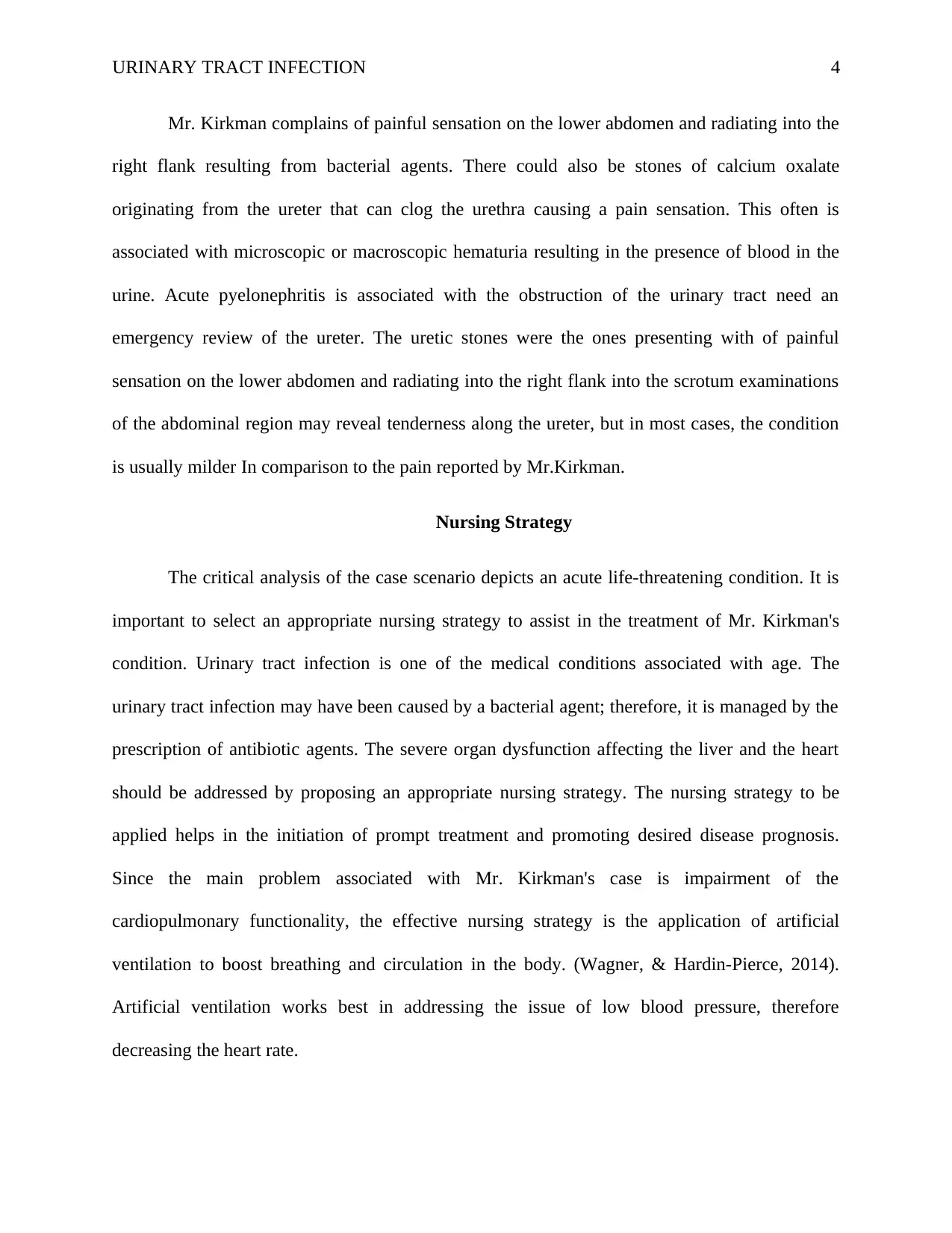
URINARY TRACT INFECTION 4
Mr. Kirkman complains of painful sensation on the lower abdomen and radiating into the
right flank resulting from bacterial agents. There could also be stones of calcium oxalate
originating from the ureter that can clog the urethra causing a pain sensation. This often is
associated with microscopic or macroscopic hematuria resulting in the presence of blood in the
urine. Acute pyelonephritis is associated with the obstruction of the urinary tract need an
emergency review of the ureter. The uretic stones were the ones presenting with of painful
sensation on the lower abdomen and radiating into the right flank into the scrotum examinations
of the abdominal region may reveal tenderness along the ureter, but in most cases, the condition
is usually milder In comparison to the pain reported by Mr.Kirkman.
Nursing Strategy
The critical analysis of the case scenario depicts an acute life-threatening condition. It is
important to select an appropriate nursing strategy to assist in the treatment of Mr. Kirkman's
condition. Urinary tract infection is one of the medical conditions associated with age. The
urinary tract infection may have been caused by a bacterial agent; therefore, it is managed by the
prescription of antibiotic agents. The severe organ dysfunction affecting the liver and the heart
should be addressed by proposing an appropriate nursing strategy. The nursing strategy to be
applied helps in the initiation of prompt treatment and promoting desired disease prognosis.
Since the main problem associated with Mr. Kirkman's case is impairment of the
cardiopulmonary functionality, the effective nursing strategy is the application of artificial
ventilation to boost breathing and circulation in the body. (Wagner, & Hardin-Pierce, 2014).
Artificial ventilation works best in addressing the issue of low blood pressure, therefore
decreasing the heart rate.
Mr. Kirkman complains of painful sensation on the lower abdomen and radiating into the
right flank resulting from bacterial agents. There could also be stones of calcium oxalate
originating from the ureter that can clog the urethra causing a pain sensation. This often is
associated with microscopic or macroscopic hematuria resulting in the presence of blood in the
urine. Acute pyelonephritis is associated with the obstruction of the urinary tract need an
emergency review of the ureter. The uretic stones were the ones presenting with of painful
sensation on the lower abdomen and radiating into the right flank into the scrotum examinations
of the abdominal region may reveal tenderness along the ureter, but in most cases, the condition
is usually milder In comparison to the pain reported by Mr.Kirkman.
Nursing Strategy
The critical analysis of the case scenario depicts an acute life-threatening condition. It is
important to select an appropriate nursing strategy to assist in the treatment of Mr. Kirkman's
condition. Urinary tract infection is one of the medical conditions associated with age. The
urinary tract infection may have been caused by a bacterial agent; therefore, it is managed by the
prescription of antibiotic agents. The severe organ dysfunction affecting the liver and the heart
should be addressed by proposing an appropriate nursing strategy. The nursing strategy to be
applied helps in the initiation of prompt treatment and promoting desired disease prognosis.
Since the main problem associated with Mr. Kirkman's case is impairment of the
cardiopulmonary functionality, the effective nursing strategy is the application of artificial
ventilation to boost breathing and circulation in the body. (Wagner, & Hardin-Pierce, 2014).
Artificial ventilation works best in addressing the issue of low blood pressure, therefore
decreasing the heart rate.
Paraphrase This Document
Need a fresh take? Get an instant paraphrase of this document with our AI Paraphraser
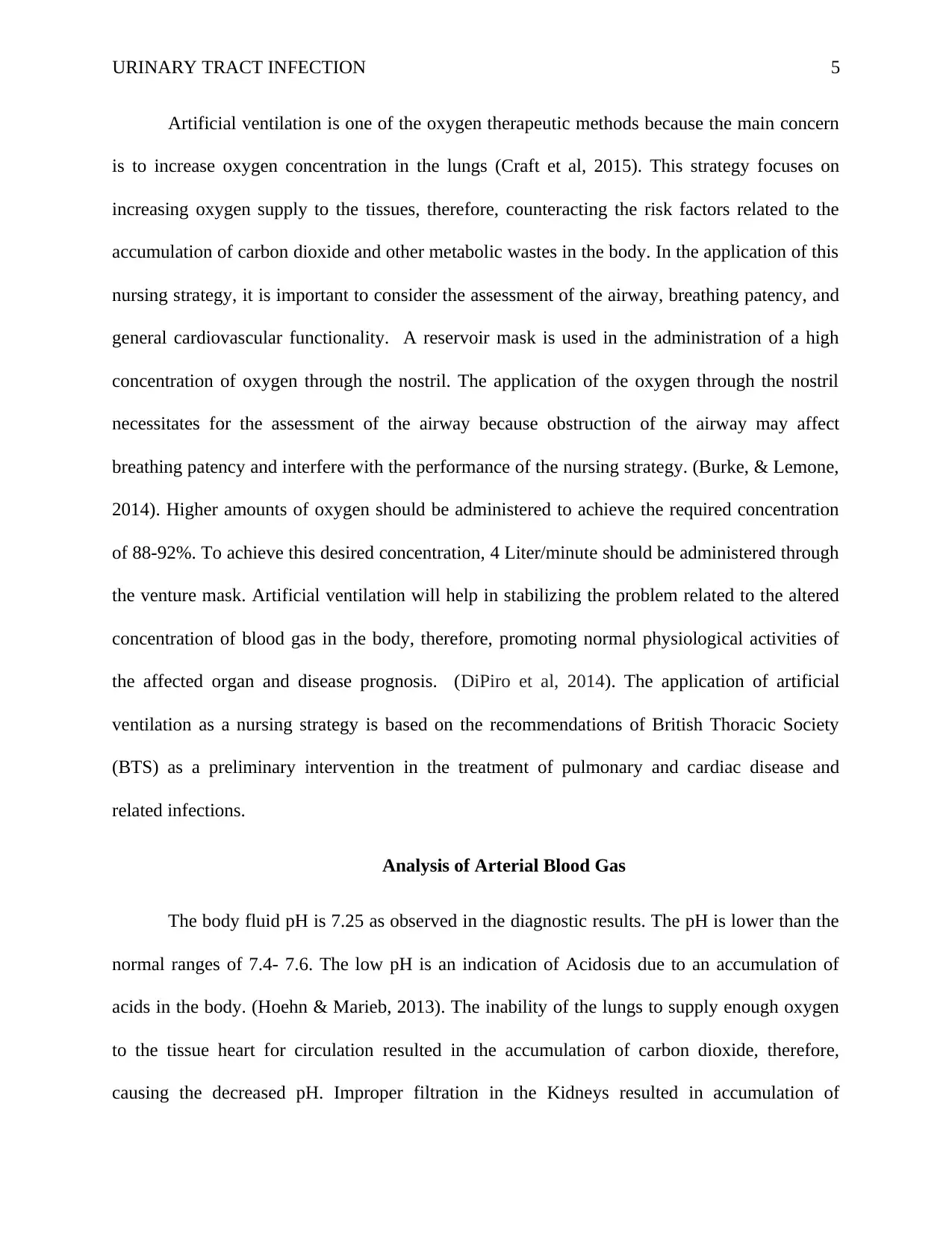
URINARY TRACT INFECTION 5
Artificial ventilation is one of the oxygen therapeutic methods because the main concern
is to increase oxygen concentration in the lungs (Craft et al, 2015). This strategy focuses on
increasing oxygen supply to the tissues, therefore, counteracting the risk factors related to the
accumulation of carbon dioxide and other metabolic wastes in the body. In the application of this
nursing strategy, it is important to consider the assessment of the airway, breathing patency, and
general cardiovascular functionality. A reservoir mask is used in the administration of a high
concentration of oxygen through the nostril. The application of the oxygen through the nostril
necessitates for the assessment of the airway because obstruction of the airway may affect
breathing patency and interfere with the performance of the nursing strategy. (Burke, & Lemone,
2014). Higher amounts of oxygen should be administered to achieve the required concentration
of 88-92%. To achieve this desired concentration, 4 Liter/minute should be administered through
the venture mask. Artificial ventilation will help in stabilizing the problem related to the altered
concentration of blood gas in the body, therefore, promoting normal physiological activities of
the affected organ and disease prognosis. (DiPiro et al, 2014). The application of artificial
ventilation as a nursing strategy is based on the recommendations of British Thoracic Society
(BTS) as a preliminary intervention in the treatment of pulmonary and cardiac disease and
related infections.
Analysis of Arterial Blood Gas
The body fluid pH is 7.25 as observed in the diagnostic results. The pH is lower than the
normal ranges of 7.4- 7.6. The low pH is an indication of Acidosis due to an accumulation of
acids in the body. (Hoehn & Marieb, 2013). The inability of the lungs to supply enough oxygen
to the tissue heart for circulation resulted in the accumulation of carbon dioxide, therefore,
causing the decreased pH. Improper filtration in the Kidneys resulted in accumulation of
Artificial ventilation is one of the oxygen therapeutic methods because the main concern
is to increase oxygen concentration in the lungs (Craft et al, 2015). This strategy focuses on
increasing oxygen supply to the tissues, therefore, counteracting the risk factors related to the
accumulation of carbon dioxide and other metabolic wastes in the body. In the application of this
nursing strategy, it is important to consider the assessment of the airway, breathing patency, and
general cardiovascular functionality. A reservoir mask is used in the administration of a high
concentration of oxygen through the nostril. The application of the oxygen through the nostril
necessitates for the assessment of the airway because obstruction of the airway may affect
breathing patency and interfere with the performance of the nursing strategy. (Burke, & Lemone,
2014). Higher amounts of oxygen should be administered to achieve the required concentration
of 88-92%. To achieve this desired concentration, 4 Liter/minute should be administered through
the venture mask. Artificial ventilation will help in stabilizing the problem related to the altered
concentration of blood gas in the body, therefore, promoting normal physiological activities of
the affected organ and disease prognosis. (DiPiro et al, 2014). The application of artificial
ventilation as a nursing strategy is based on the recommendations of British Thoracic Society
(BTS) as a preliminary intervention in the treatment of pulmonary and cardiac disease and
related infections.
Analysis of Arterial Blood Gas
The body fluid pH is 7.25 as observed in the diagnostic results. The pH is lower than the
normal ranges of 7.4- 7.6. The low pH is an indication of Acidosis due to an accumulation of
acids in the body. (Hoehn & Marieb, 2013). The inability of the lungs to supply enough oxygen
to the tissue heart for circulation resulted in the accumulation of carbon dioxide, therefore,
causing the decreased pH. Improper filtration in the Kidneys resulted in accumulation of
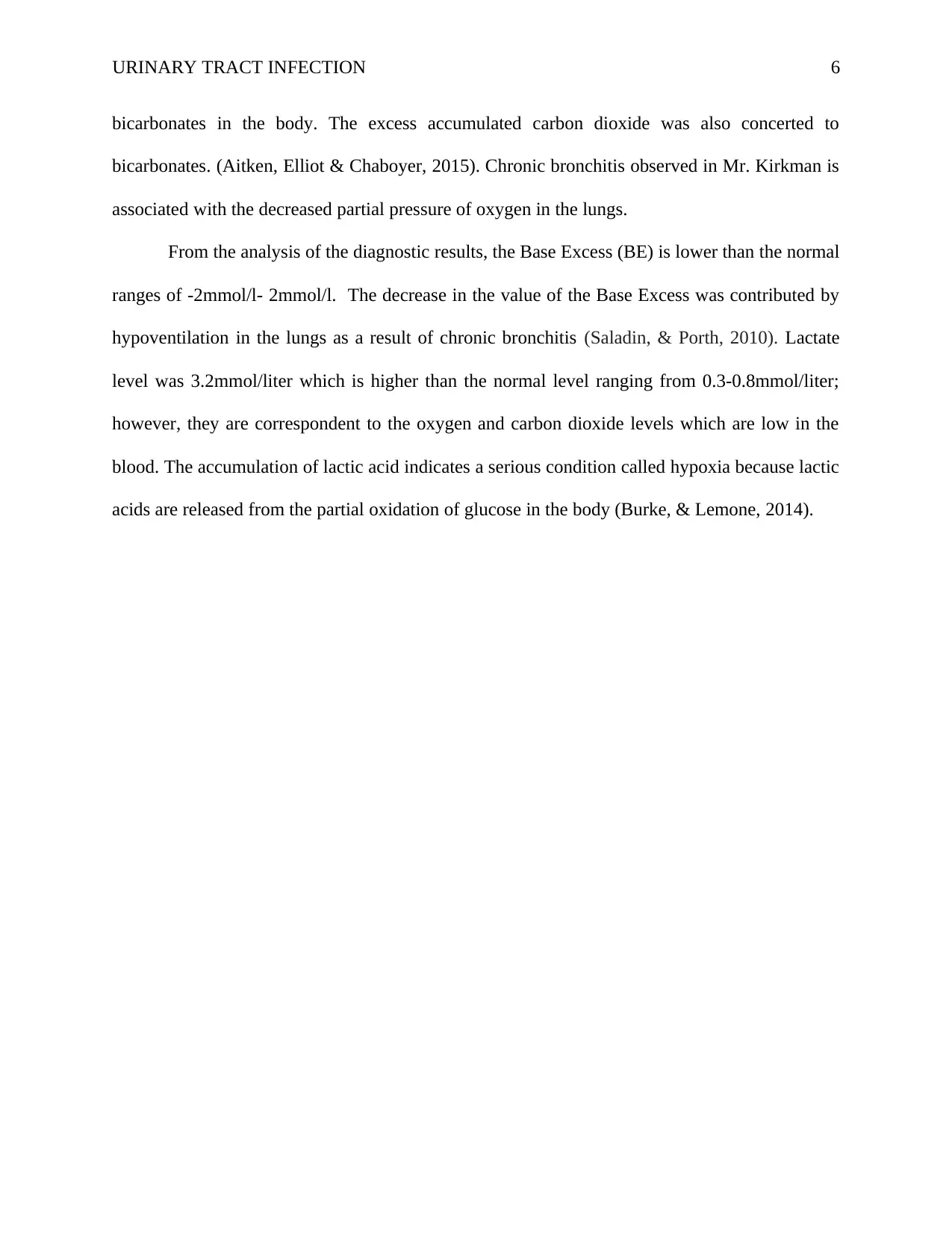
URINARY TRACT INFECTION 6
bicarbonates in the body. The excess accumulated carbon dioxide was also concerted to
bicarbonates. (Aitken, Elliot & Chaboyer, 2015). Chronic bronchitis observed in Mr. Kirkman is
associated with the decreased partial pressure of oxygen in the lungs.
From the analysis of the diagnostic results, the Base Excess (BE) is lower than the normal
ranges of -2mmol/l- 2mmol/l. The decrease in the value of the Base Excess was contributed by
hypoventilation in the lungs as a result of chronic bronchitis (Saladin, & Porth, 2010). Lactate
level was 3.2mmol/liter which is higher than the normal level ranging from 0.3-0.8mmol/liter;
however, they are correspondent to the oxygen and carbon dioxide levels which are low in the
blood. The accumulation of lactic acid indicates a serious condition called hypoxia because lactic
acids are released from the partial oxidation of glucose in the body (Burke, & Lemone, 2014).
bicarbonates in the body. The excess accumulated carbon dioxide was also concerted to
bicarbonates. (Aitken, Elliot & Chaboyer, 2015). Chronic bronchitis observed in Mr. Kirkman is
associated with the decreased partial pressure of oxygen in the lungs.
From the analysis of the diagnostic results, the Base Excess (BE) is lower than the normal
ranges of -2mmol/l- 2mmol/l. The decrease in the value of the Base Excess was contributed by
hypoventilation in the lungs as a result of chronic bronchitis (Saladin, & Porth, 2010). Lactate
level was 3.2mmol/liter which is higher than the normal level ranging from 0.3-0.8mmol/liter;
however, they are correspondent to the oxygen and carbon dioxide levels which are low in the
blood. The accumulation of lactic acid indicates a serious condition called hypoxia because lactic
acids are released from the partial oxidation of glucose in the body (Burke, & Lemone, 2014).
⊘ This is a preview!⊘
Do you want full access?
Subscribe today to unlock all pages.

Trusted by 1+ million students worldwide
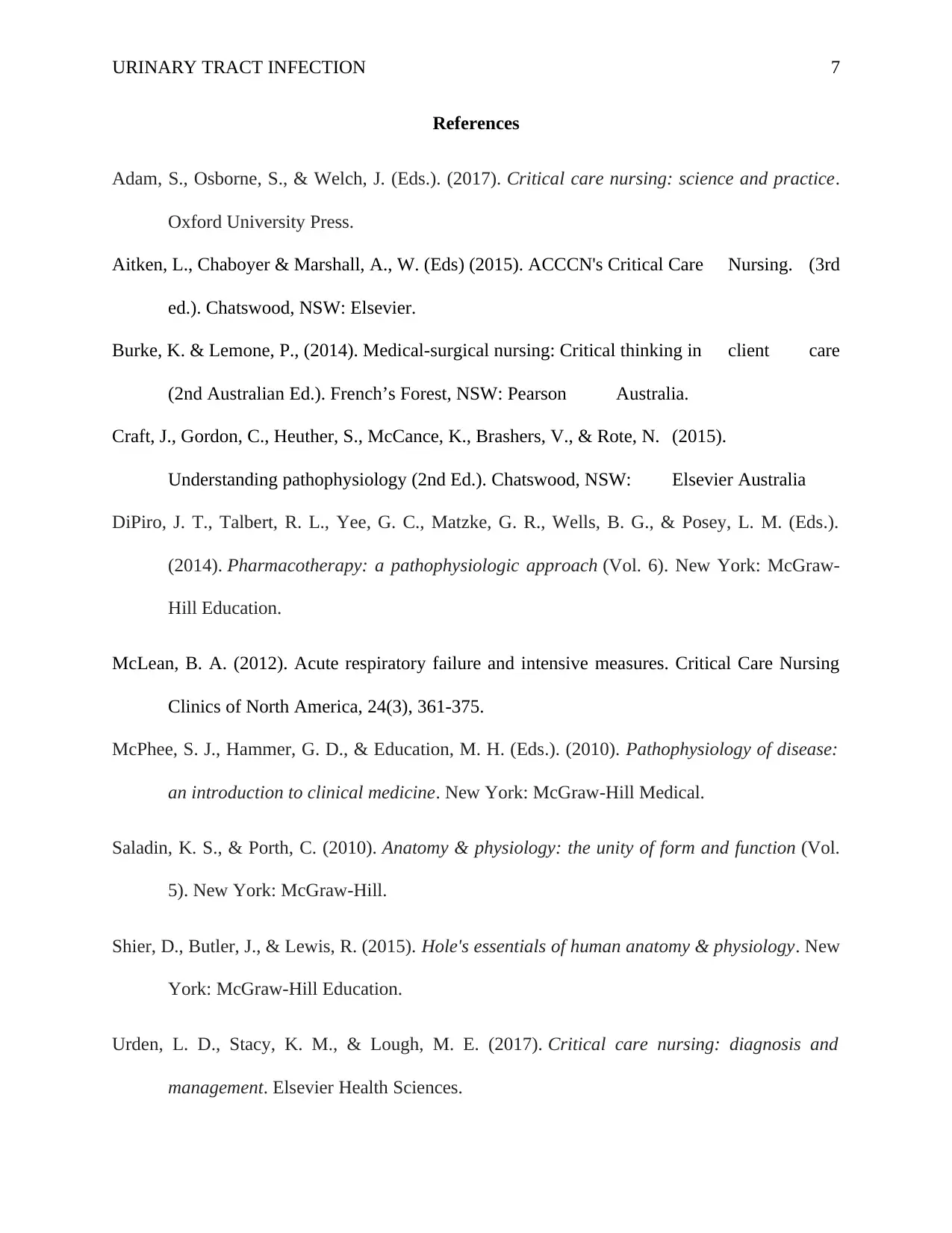
URINARY TRACT INFECTION 7
References
Adam, S., Osborne, S., & Welch, J. (Eds.). (2017). Critical care nursing: science and practice.
Oxford University Press.
Aitken, L., Chaboyer & Marshall, A., W. (Eds) (2015). ACCCN's Critical Care Nursing. (3rd
ed.). Chatswood, NSW: Elsevier.
Burke, K. & Lemone, P., (2014). Medical-surgical nursing: Critical thinking in client care
(2nd Australian Ed.). French’s Forest, NSW: Pearson Australia.
Craft, J., Gordon, C., Heuther, S., McCance, K., Brashers, V., & Rote, N. (2015).
Understanding pathophysiology (2nd Ed.). Chatswood, NSW: Elsevier Australia
DiPiro, J. T., Talbert, R. L., Yee, G. C., Matzke, G. R., Wells, B. G., & Posey, L. M. (Eds.).
(2014). Pharmacotherapy: a pathophysiologic approach (Vol. 6). New York: McGraw-
Hill Education.
McLean, B. A. (2012). Acute respiratory failure and intensive measures. Critical Care Nursing
Clinics of North America, 24(3), 361-375.
McPhee, S. J., Hammer, G. D., & Education, M. H. (Eds.). (2010). Pathophysiology of disease:
an introduction to clinical medicine. New York: McGraw-Hill Medical.
Saladin, K. S., & Porth, C. (2010). Anatomy & physiology: the unity of form and function (Vol.
5). New York: McGraw-Hill.
Shier, D., Butler, J., & Lewis, R. (2015). Hole's essentials of human anatomy & physiology. New
York: McGraw-Hill Education.
Urden, L. D., Stacy, K. M., & Lough, M. E. (2017). Critical care nursing: diagnosis and
management. Elsevier Health Sciences.
References
Adam, S., Osborne, S., & Welch, J. (Eds.). (2017). Critical care nursing: science and practice.
Oxford University Press.
Aitken, L., Chaboyer & Marshall, A., W. (Eds) (2015). ACCCN's Critical Care Nursing. (3rd
ed.). Chatswood, NSW: Elsevier.
Burke, K. & Lemone, P., (2014). Medical-surgical nursing: Critical thinking in client care
(2nd Australian Ed.). French’s Forest, NSW: Pearson Australia.
Craft, J., Gordon, C., Heuther, S., McCance, K., Brashers, V., & Rote, N. (2015).
Understanding pathophysiology (2nd Ed.). Chatswood, NSW: Elsevier Australia
DiPiro, J. T., Talbert, R. L., Yee, G. C., Matzke, G. R., Wells, B. G., & Posey, L. M. (Eds.).
(2014). Pharmacotherapy: a pathophysiologic approach (Vol. 6). New York: McGraw-
Hill Education.
McLean, B. A. (2012). Acute respiratory failure and intensive measures. Critical Care Nursing
Clinics of North America, 24(3), 361-375.
McPhee, S. J., Hammer, G. D., & Education, M. H. (Eds.). (2010). Pathophysiology of disease:
an introduction to clinical medicine. New York: McGraw-Hill Medical.
Saladin, K. S., & Porth, C. (2010). Anatomy & physiology: the unity of form and function (Vol.
5). New York: McGraw-Hill.
Shier, D., Butler, J., & Lewis, R. (2015). Hole's essentials of human anatomy & physiology. New
York: McGraw-Hill Education.
Urden, L. D., Stacy, K. M., & Lough, M. E. (2017). Critical care nursing: diagnosis and
management. Elsevier Health Sciences.
Paraphrase This Document
Need a fresh take? Get an instant paraphrase of this document with our AI Paraphraser

URINARY TRACT INFECTION 8
Wagner, K. D., & Hardin-Pierce, M. G. (2014). High-acuity nursing (6th Ed.). Upper Saddle
River, NJ: Pearson.
Wagner, K. D., & Hardin-Pierce, M. G. (2014). High-acuity nursing (6th Ed.). Upper Saddle
River, NJ: Pearson.
1 out of 8
Related Documents
Your All-in-One AI-Powered Toolkit for Academic Success.
+13062052269
info@desklib.com
Available 24*7 on WhatsApp / Email
![[object Object]](/_next/static/media/star-bottom.7253800d.svg)
Unlock your academic potential
Copyright © 2020–2025 A2Z Services. All Rights Reserved. Developed and managed by ZUCOL.





